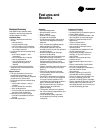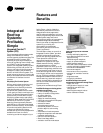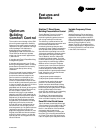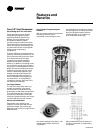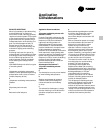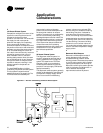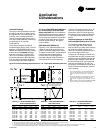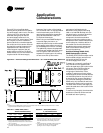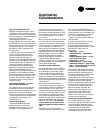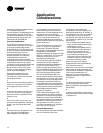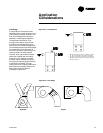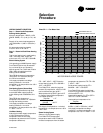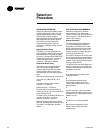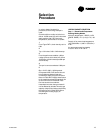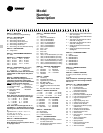
13RT-PRC010-EN
High Capacity Evaporator Coil
Rooftops are popular because of their
“packaged” nature. Everything needed
is contained in one box; mix-matching is
neither necessary nor available. With this
convenience comes some
disadvantages; one is the rooftop’s
cooling capacity may not exactly match
the building load. It is conceivable that a
50 ton rooftop would need to be used on
an application that is 41 tons, simply
because the 40 ton rooftop does not
meet capacity.
In order to avoid such occurrences, and
to more closely match the rooftop’s
capacity to the building load, a high
capacity evaporator coil option is
available on all IntelliPak® Rooftops 20 to
105 tons. These high capacity coils have
an increased number of evaporator coil
rows as compared to standard and
enhanced evaporator tube surfaces,
resulting in a higher capacity. Capacity
tables for both standard and high
capacity coils are available in the cooling
data section of this catalog. See Table
PD-43 for the pressure drops associated
with the high capacity coil option. This
pressure drop should be added to the
total static pressure used to size the
supply fan motor.
Low Ambient Operation — Human
Interface Recommendations
Who wants to be on a roof at sub-zero
temperatures? We can understand a
service technician’s reluctance to do this;
that’s why we recommend using a
remote mounted Human Interface Panel.
The service technician can troubleshoot
and diagnose in the comfort of a
mechanical room.
Corrosive Atmospheres
Trane’s IntelliPak® Rooftops are
designed and built to industrial
standards and will perform to those
standards for an extended period
depending on the hours of use, the
quality of maintenance performed, and
the regularity of that maintenance. One
factor that can have an adverse effect on
unit life is its operation in a corrosive
environment.
When rooftops are operated in corrosive
environments, Trane recommends that
copper fins be utilized on the condenser
and/or evaporator coil. Because copper
is more resistant to corrosion than
aluminum, coil life expectancy is greatly
increased. Some industry applications
expose equipment to corrosive agents
that even copper cannot fully resist. For
those special applications, a baked
phenolic resin coating (i.e. Heresite) is
highly desirable. Baked phenolic
coatings or copper fins on the condenser
and/or evaporator coils are available on
Trane’s IntelliPak Rooftops.
Ventilation Override Sequences
One of the benefits of using an exhaust
fan rather than a return fan, in addition
to the benefits of lower energy usage
and improved building pressurization
control, is that the rooftop can be used
as part of a ventilation override system.
Several types of sequences can be easily
done when exhaust fans are a part of the
rooftop system.
What would initiate the ventilation
override control sequence? Typically, a
manual switch is used and located near
the fire protection control panel. This
enables the fire department access to the
control for use during or after a fire. It is
also possible to initiate the sequence
from a field-installed automatic smoke
detector. In either case, a contact closure
begins the ventilation override control
sequence. CAUTION!: The ventilation
override system should not be used to
signal the presence of smoke caused by
a fire.
Trane can provide five (5) different
ventilation override sequences on both
CV and VAV IntelliPak® Rooftops. For
your convenience the sequences can be
factory preset or fully field editable from
the Human Interface Panel or Tracer®.
Any or all five sequences may be
“locked” in by the user at the Human
Interface Panel.
The user can customize up to five (5)
different override sequences for
purposes such as smoke control. The
following parameters within the unit can
be defined for each of the five
sequences:
• Supply Fan — on/off
• Inlet Guide Vanes — open/closed/
controlling
• Variable Frequency Drives — on (60
Hz)/off (0 Hz)/controlling
• Exhaust Fan — on/off
• Exhaust Dampers — open/closed
• Economizer dampers — open/closed
• Heat — off/controlling (output for) VAV
Boxes — open/controlling
Compressors and condenser fans are
shut down for any Ventilation Override
sequence. Factory preset sequences
include unit Off, Exhaust, Purge, Purge
with duct pressure control, and
Pressurization. Any of the user-defined
Ventilation Override sequences can be
initiated by closing a field supplied
switch or contacts connected to an input
on the Ventilation Override Module. If
more than one ventilation override
sequence is being requested, the
sequence with the highest priority is
initiated. Refer to the Sequence of
Operation provided in the Control
section of this catalog for more details
on each override sequence.
Natural Gas Heating Considerations
The IntelliPak standard, or limited
modulation, gas heat exchangers are not
recommended for applications with
mixed air conditions entering the heat
exchanger below 50°F. Mixed air
temperatures below 50°F can cause
condensation to form on the heat
Application
Considerations



